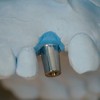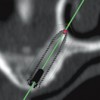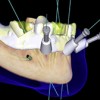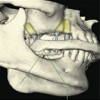As noted during previous programs, most patients are able to function effectively and comfortably with conventional maxillary complete dentures. There are many patients, however, for psychological and/or psychosocial reasons, that wish to be restored with a fixed implant supported prosthesis. The criteria used in patient selection is discussed in detail in this program. In addition, three types of implant support prostheses will be described in detail including the classical fixed hybrid prosthesis originally developed by the Branemark group, the metal ceramic fixed prosthesis, and the so called fixed detachable prosthesis retained by a milled bar.
1. 7. Edentulous Maxilla – Fixed Prostheses John Beumer III DDS, MS Hiroaki Okabe CDT Jungo Endo CDT Division of Advanced Prosthodontics, Biomaterials and Hospital Dentistry, UCLA This program of instruction is protected by copyright ©. No portion of this program of instruction may be reproduced, recorded or transferred by any means electronic, digital, photographic, mechanical etc., or by any information storage or retrieval system, without prior permission.
2. Edentulous Maxilla – Fixed ProsthesesPatient selection and treatment planning based on:v Biomechanicsv Resorptive patterns and jaw relationsv Lip linev Costv Patient compliance
3. Fixed prostheses – Edentulous Maxilla Issues to Consider• Resorption pattern and maxillomandibular relationships• Sinus architecture • A-P spread• Esthetics • Lip line• Phonetics and Hygiene • Hygiene access vs speech articulation vs compliance• Economics• Technical Challenges • Expertise of lab personnel • Implant placement • Passively fitting castings
4. DefinitionsImplant supported prosthesis – All theforces of occlusion are borne by the implants.Can be either fixed partial dentures orremovable overlay dentures.Implant assisted prosthesis – The forces ofocclusion are shared between the implants andthe mucoperiosteum. Always removableoverlay dentures.
5. Implant Supported Prostheses – Biomechanics Edentulous maxillaMinimum requirements from a biomechanicalperspective v Six or more implants v Minimum of 2 cm of A-P spread v Distal implant must be at least 10 mm in length Few patients qualify and if these conditions cannot be met implant assisted designs are recommended.
6. Implant Supported Prosthesis Arrangement of implants “ Maxilla – Anterior-Posterior Spread required for implant supported prosthesis – 2 cm or moreLess than the abovedictates use of an implant A-P Spreadassisted prosthesis
7. Maxilla – Pattern of resorption.Following extraction, resorption is from buccal-labial towards the lingual.Labialplate
8. Fixed Prostheses – Resorptive patterns and Maxillo-mandibular Relationships The normal patterns of resorption result in pseudo class III jaw relations. In these situations Overdentures (either implant supported or implant assisted) are preferred over fixed prostheses. Why?Removable overlay dentures with properly extended and contoureddenture flanges provide better lip support and facial contours.
9. Fixed Prostheses – Resorptive patterns and Maxillo-mandibular Relationshipsv Favorable jaw relations and alveolar ridge contoursv This patient is a good candidate for fixed.
10. Fixed – Resorption pattern and maxillomandibular relationships v Following extraction of maxillary teeth the labial surfaces of the alveolar process resorb creating a pseuodo Class III jaw relationship in most patients.” If such patients are restored withfixed, the labial surfaces of theanterior teeth are far anterior tothe labial contours of the alveolarridge.” Result: Inadequatesupport for the upper lip.
11. Esthetics – Lip Support Fixed vs Removable ” Fixed in retrospect was a poor choice ” As the patient aged and lost tonus of the lip musculature lip contours became deficient
12. Implant supported fixed prosthesis Patient selection – Jaw relations Jaw relations: Labial surfaces of the anterior teeth should be on the same plane as the alveolar ridge if lip contours are to be restored with a fixed prosthesis.
13. Ideal patient would present with followingclinical findings: ” Favorable jaw relation ” Low lip line ” Minimal sinus pneumatization ” Compliant
14. Implant supported fixed prosthesis Patient selection – Lip line This patient presents with a high lip line. The best esthetic result would be attained with an implant assisted overdenture or a fixed detachable prosthesis.
15. Fixed Patients with unfavorable jaw relationsThe speech vs hygiene access dilemma v If you close the spaces and provide lip support access for oral hygiene is compromised v If you provide hygiene access, you compromise lip support and speech articulation
16. Fixed The speech vs hygiene access dilemma v If you close the spaces and provide lip support access for oral hygiene is compromised” If one incorporates a ridge lap into the design, these estheticsand phonetic difficulties are resolved but at the expense ofhygiene access. Note the accumulation of plaque beneath thisfixed hybrid prosthesis.
17. Phonetics and esthetics vs hygiene accessFixed vs removable ” Much easier to clean beneath tissue bar than beneath fixed partial denture
18. Fixed and Sinus PneumatizationOften, even though a patient may be a good candidatefor fixed, pneumatization of the maxillary sinuses maypreclude placement of implants far enough posteriorlyto achieve sufficient A-P spread. Options:v Sinus lift and graftv All on fourv Angled implantsv Zygomatic implants
19. Sinus lift and graftv Provides bone sites in the posterior maxilla.v This is a predictable option
20. All on FourIssues of concernv Short implants in the distal positionsv Cantilevers
21. All on Four with axial angulationProblemsv Implant overload and loss of the distal implantsv This option is not predictable and not recommended
22. Angled Implantsv Posterior implants parallel to the anterior wall of the sinusv Longer implants with better primary stabilityv Distal implants exit more posteriorly eliminating cantilever
23. Angled Implantsv Long implants in native bonev Better initial primary stabilityv Optimization of anterior posterior-spreadv Elimination of the cantilever.
24. Angled Implants Up-right = Cantilever vs Tilted= No CantileverBevilacqua M, Tealdo T, Menini M, Pera F, Ravera G, Drago C, Pera P.The influence of cantilever length and implant inclination on stressdistribution for maxillary implant-supported full-fixed prostheses.J Prosthet Dent 2010 (In submission)
25. Angled ImplantsConcerns Long term followup is lacking
26. 24 months X-Ray follow-upTealdo T, Bevilacqua M, Pera F, Menini M, Ravera G, Drago C, Pera PImmediate function with fixed implant-supported maxillary denture: a 12-months pilot studyJournal Prosthetic Dentistry 2008; 99:351-360.
27. 36m X-ray follow-upTealdo T, Bevilacqua M, Pera F, Menini M, Ravera G, Drago C, Pera PClinical and radiographic outcomes of immediate versus delayed loading ofdental implants in edentulous maxillae: a 36-months prospective study.International Journal of Prosthodontics 2010. Accepted forpublication.
28. Zygomatic Implantsv Introduced by P. I. Branemark in the 1980’s as an alternative to bone grafting in patients with pneumatized maxillary sinusesv They are designed to be used in concert with 4 axially placed implants in the premaxilla.v Success rates have been above 90% in almost all clinical reports (Branemark et al, 1998; Aparicio etal, 2006; Bedrossian et al, 2006)
29. Zygomatic Implants v Implants are splinted together with rigid metal frameworks. v This is a PFM fixed prosthesis. v Note the metal occlusal surfaces
30. Zygomatic ImplantsComplications v Zygomatic implants exiting on the palatal side may limit the tongue space an affect speech articulation v Oronasal fistula formation v Periorbital hematoma v Penetration into the orbit v Facial swelling
31. Types of Fixed Prostheses PFM fixed prosthesis Fixed Hybrid ProsthesisFixed hybrid prosthesis v Metal framework, denture teeth and pink acrylic resinPFM fixed prosthesis v Porcelain fused to metal with the ginigival contours restores with pink porcelain
32. Fixed Hybrid ProsthesisFixed hybrid prosthesis This design was used frequently in the 80’s. Note the spaces beneath the bridge. These spaces facilitate hygiene but during speech air escapes through these spaces adversely affecting speech articulation.
33. PFM fixed prosthesisToday, we fabricate maxillary fixed restorations withporcelain fused to metal restorations and attempt toclose these spaces consistent with hygiene access
34. Candidates for fixed prosthesis demonstratev Favorable jaw relationsv Minimal resorption with little sinus pneumatizationv Low smile and laugh line
35. Minimum requirements for Fixed ProsthesesImplant numbers and position v Minimum number – 6 implants v Minimum of 2cm of A-P spread v Implants must be placed in tooth positions v If possible screw access holes for the implants should exit the cingulum area of the anterior teeth and through the center of the occlusal table of posterior teeth.
36. Candidates for fixed prosthesis demonstrate” Smile line – If high overdenture is preferred” Lip support – If required overdenture is preferred
37. Surgical templatesDesign criteria v Based on a diagnostic wax-up or a duplication of the existing denture of the patient. v Palate retained for accurate positioning v Lingual portion removed
38. Clinical case presentationPatient was treatment planned to receive an implantsupported fixed partial denture
39. Design Principlesv Custom abutments or custom substructures as neededv No ridge laps in the posterior segmentsv Prosthesis is made in segmentsv Screw retained
40. Impressions and making master casts A soft tissue cast is made to represent gingival contours. It should be detachable from the master cast.
41. Full Contour Wax PatternUcla abutments with resin pattern sleeves aresecured to the fixture analogues in the mastercast.
42. Full Contour Wax Patternv A full contour wax pattern is developed from. Note that several of the implants demonstrate excessively labial inclination.v The desired contours are recorded with a silicone template. This will be used later to verify the wax-cut back
43. PFM Fixed ProsthesisWax cutback is completed and the custom abutmentsare milled to a 3 degree taper Note the channels developed for the lingual retention screws.
44. PFM Fixed Prosthesis Custom abutments and substructuresv Milling is refined in metal using a milling machine
45. PFM Fixed Prosthesisv Custom abutments are polished and verified intra-orally
46. PFM Fixed Prosthesisv Additionalexamples of custom substructures.v They are milled to a three degree taper.v There must be hygiene access beneath the substructures
47. PFM Fixed Prosthesis Super structures v Wax pattern for metal framework (super structure) for PFM restoration is then developedNote the channels for the lingual retention screws.
48. PFM Fixed Prosthesis Super structures v Completed metal framework (super structure) for anterior segment of the PFM fixed prosthesis. v The lingual retention screw channels are tapped.
49. PFM Fixed Prosthesis Super structuresBefore adding the porcelain check to see that the metal cutback was sufficient to add porcelain of desired contour andthickness
50. PFM Fixed Prosthesis Super structuresv Metal framework elements are tried in position and solder relation records made to correct for discrepancies in fit.
51. PFM Fixed Prosthesis” Completed prosthesis” Note the custom abutments (arrows)
52. PFM Fixed Prosthesisv Completed and assembled fixed partial denture
53. PFM Fixed ProsthesisOcclusion v Opposing fixed hybrid prosthesis – Group function Right working Left working
54. PFM Fixed Prosthesis Inserting the prosthesisv Healing abutments areremovedv Posterior segments and thecustom abutments aresecured with gold screwsv The anterior segments arescrewed into position
55. PFM Fixed Prosthesisl Inserted restorationl Occlusion is designed for group functionl Note the hygiene access
56. PFM Fixed Prosthesis ” Completed prosthesis ” Note lip line during high smileOral hygieneis facilitatedwithsuperfloss
57. PFM Fixed Prosthesis 14 year followup. Denture teeth of the mandibular fixed hybrid prosthesis have been replaced once.
58. PFM fixed prosthesis
59. PFM fixed prosthesisv Anterior segment securedv Note the rigid type tube lock attachments (arrows). The posterior segments will be attached to the anterior segment by means of these rigid attachments
60. PFM fixed prosthesis
61. PFM fixed prosthesis
62. PFM fixed prosthesis
63. PFM fixed prosthesisRight working positionOcclusion Anterior guidance
64. PFM fixed prosthesisRidge lap design with pink porcelain
65. Implant supported fixed prosthesisRidge lap design with pink porcelain
66. Fixed Detachable Prosthesis (Implant supported overdentures)Indications v Patient wants a fixed type prosthesis v Patient presents with significant resorption of the maxilla and requires a denture flange v Patient presents with sufficient bone for placement of at least 6 implants with 2 cm of A-P spread
67. Fixed Detachable Prosthesis (Implant supported overdentures)” This patient has sufficient numbers of implants (6) placed with sufficient A-P spread (minimum 2cm) to permit fabrication of an implant supported overlay denture.
68. Fixed Detachable Prosthesis (Implant supported overdentures)” Master impression is border molded in order to record the thickness of the labial and buccal denture flange necessary to provide appropriate support for the upper lip.Transfer impression copings (closed tray) were used an thecorrected impression made of polysiloxane.
69. Fixed Detachable Prosthesis (Implant supported overdentures)v The cast is surveyed to determine the proper path of insertionv Tissue bar is milled to 3 degree taperv The bar must fit within the contours of the denture without compromising palatal contours or tooth positions.
70. Tissue bar designsv The 3 degree taper provides excellent stability and facilitates retentionv Hader and Locator attachments, because of their low profiles, are used for attachments Locator attachments Hader attachments Hader attachments Super structures with “Hader” clips inserted
71. Fixed Detachable Prosthesis (Implant supported overdentures)” A metal superstructure is fabricated to house the attachments, precisely engage the milled tissue bar and provide rigidity to the prosthesis In this patient Hader attachments were used.
72. Fixed Detachable Prosthesis (Implant supported overdentures) The completed prosthesis”The metal superstructure contains the clip housings and alsoprovides rigidity to the prosthesis. Since there is virtually nomovement of the overlay denture during function there is very littlewear of the plastic Hader clips. They need replacement everythree to five years.
73. Fixed Detachable Prosthesis (Implant supported overdentures)Rentention bar and prosthesis in position Occlusion: Group function Note: Opposing arch is composed of implants supported fixed partial dentures and natural dentition
74. Fixed Detachable Prosthesis (Implant supported overdentures)” The master cast must be surveyed to account for the alveolar undercuts and identify the proper path of insertion.” This design also uses Hader attachments. They are used because of their low profile and because they are easily replaced when needed.” The distal Hader clips are parallel to the anterior clips and located between the last two implants. The bar is milled to a 3 degree taper using a milling machine.
75. Fixed Detachable Prosthesis (Implant supported overdentures) Metal superstructure. Metal housings are placed on the bar and the wax pattern is developed. The metal is cast to these metal housings.
76. Fixed Detachable Prosthesis (Implant supported overdentures)Completed prosthesisv Occlusion is lingualized with bilateral balance.Note: v The fixed in the mandible was redone in order to idealize the plane of occlusion and opposing tooth contours. v Close patient followup is mandatory. Given that the opposing dentition is restored with implant supported fixed partial dentures with porcelain occlusal surfaces rapid wear of the posterior denture teeth and of the overlay denture and loss of VDO should be anticipated.
77. Fixed Detachable Prosthesis (Implant supported overdentures) 12 year followupv Note the occlusal wear and the slight loss of vertical dimension of occlusionv Erythematous tissue beneath the tissue bar
78. v Visitffofr.org for hundreds of additional lectures on Complete Dentures, Implant Dentistry, Removable Partial Dentures, Esthetic Dentistry and Maxillofacial Prosthetics.v The lectures are free.v Our objective is to create the best and most comprehensive online programs of instruction in Prosthodontics


 Cement Retention vs Screw Retention
Cement Retention vs Screw Retention
 Prosthodontic Procedures and Complications
Prosthodontic Procedures and Complications
 Computer Guided Treatment Planning and Surgery
Computer Guided Treatment Planning and Surgery
 Angled Implants
Angled Implants
